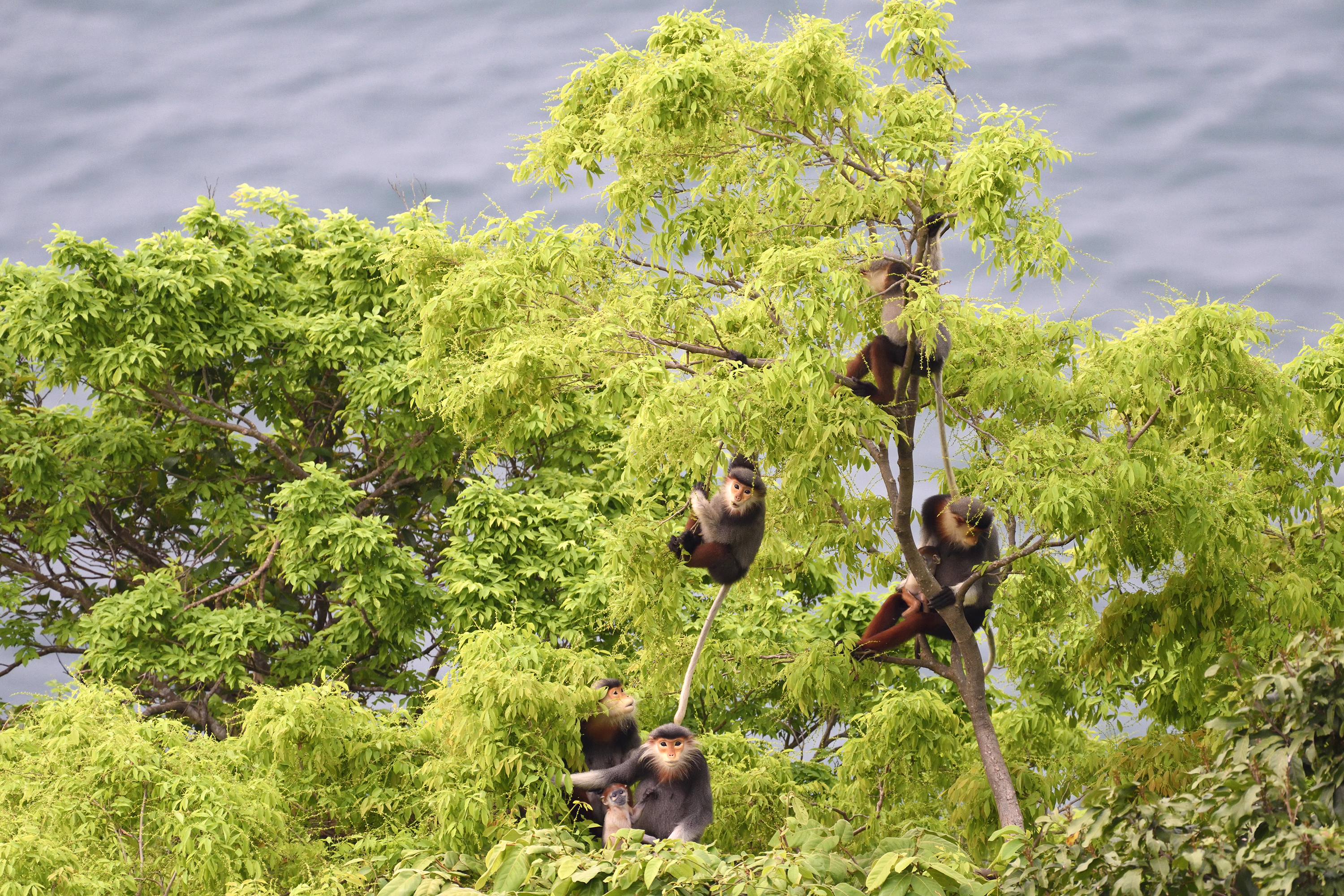Da Nang preserves, promotes biodiversity on Son Tra Peninsula by all means
Protecting forests and biodiversity in the Da Nang-based Son Tra Nature Reserve is not only for sustainable forest development but also to create unique eco-tourism products, making an important contribution to the city’s tourism development strategies. It is high time to preserve sustainability, promote biodiversity, especially on the Son Tra Peninsula in order to protect the environment in tandem with tourism development.
 |
| The Son Tra Peninsula boasts high biodiversity and unique ecosystem. Here are red-shanked douc langurs that are dubbed as ‘the queen of primates’ living on the peninsula. (Photo courtesy of GreenViet) |
High and specific biodiversity
According to Mr. Tran Huu Vy, the Director of the GreenViet biodiversity conservation centre , the Son Tra Peninsula is naturally blessed with high biodiversity and it is highly typical in term of ecosystem.
Latest research results shows that the number of plant species on the peninsula accounts for 14% of the national flora; the number of migratory birds makes up for 13.2% of the total in Viet Nam; diverse and rich marine fauna with more than 50 species of coral and coral coverage in some places reaching up to 50% of the area; some species with large populations such as monkeys and red-shanked douc langurs...
In addition, Da Nang is located at the intersection between the North and the South, which makes the flora and fauna system is unique characteristics of both regions.
According to the Son Tra - Ngu Hanh Son inter-district Forest Protection Division, the total forest area and forest development planning land in the area is 3,791ha, more than 3,685 ha of which is the forested land area. The forest coverage rate in 2021 reached 58.06%.
In the Son Tra Nature Reserve, there are a total of 1,679 species of animals and plants. Notable among them, 10 species of plants and 58 species of animals are identified as endangered, precious, rare and endemic identified according to the "red lists" released by the International Union for Conservation of Nature and Natural Resources (IUCN), the Viet Nam Red Book and the Convention on International Trade in Endangered Species of Wild Fauna and Flora (CITES).
Especially, according to research and field surveys, there are 720 individuals of brown-shanked douc langur belonging to a total of 88 herds living in the reserve.
The city has been implementing many conservation solutions and projects over the past years and mobilising many resources for forest management and protection, community participation through the payment requirements for forest environmental services.
However, conservation work in the Son Tra Nature Reserve has been affected by many factors such as the illegal exploitation of biological resources and noise pollution.
Mr. Ngo Truong Chinh, Head of the Son Tra - Ngu Hanh Son Inter-District Forest Protection Department, urged priority to be given to protecting the intact values and resources of the existing forest ecosystems on the peninsula, the conservation of species on the list of endangered, precious and rare species of plants and animals, developing genetic resources of a number of endemic species and assessing the overall status of biodiversity of the conservation area.
Besides, it is necessary to keep a sight on implementing activities of zoning, promoting regeneration and improving forest quality for poor forest areas, applying science and technology in forest management and monitoring, and carrying out scientific researches to build a background database on biodiversity.
Harmony needed between environmental protection and tourism development
Director of the Da Nang Department of Natural Resources and Environment To Van Hung said that, in addition to detailed planning solutions to effectively exploit Son Tra natural resources, it is especially necessary to consider the overall connection of the peninsula and coastal area surrounding this area.
Competent agencies should call more public engagement in implementing measures to restore ecosystems, conserving endangered and rare species, strengthening the control of illegal hunting, trading and consumption of wild animals and the management of alien species.
It is also a need to promote the implementation of economic models for sustainable use of natural resources, strengthen control over the collection, transportation and treatment of waste on the peninsula for the sake of environmental protection.
According to Mr. Phan Minh Hai, the Deputy Head of the Management Board of the Son Tra Peninsula and Da Nang tourist beaches, in order to develop harmoniously between tourism and natural resource conservation, it is necessary to strictly abide by the laws of nature.
Accordingly, it is necessary to minimise the negative impacts of fixed works on natural resources and the environment, give priority to the development of conservation areas for indigenous tree varieties of Son Tra, the propagation of flowers and medicinal plants for luring more visitors, and the preservation of endemic plant species.
Also it is highly recommended to organise environmental education programmes and environmental protection activities to raise public awareness in the conservation of red-shanked douc langurs, ancient trees and ornamental creatures on the peninsula.
As suggested by Mr. Vy, in order to avoid conflicts between nature conservation and eco-tourism exploitation, the city needs to map out an appropriate master and detailed plan for the whole peninsula.
For tourism activities on the peninsula, it is possible to pilot a fee collections from visitor to raise funding for ecosystem conservation and restoration activities on the peninsula.
The development of tourism on the peninsula in the future should minimise concreting, limiting sound, noise and light at night to avoid affecting animals and plants.
In particular, it is a good idea to soon establish a centre for environmental interpretation and nature education integrated with the reception of tourists to raise awareness of Son Tra protection and facilitate assessment and research in service for sustainable conservation.
In the long term, Son Tra District should turn itself into a biosphere reserve to create harmony between conservation and development.
Reporting by VAN HOANG - Translating by A.THU